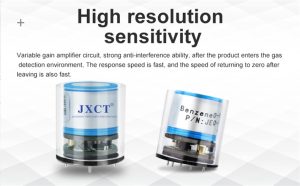In recent years, environmental pollution has become a major concern worldwide. The negative impacts of pollution on human health and the ecosystem have prompted scientists and researchers to seek innovative solutions for environmental monitoring and prevention. One such solution is the use of gas sensors, which play a crucial role in detecting and measuring various pollutants in the air, water, and soil. This article explores the power of gas sensors in environmental monitoring and highlights their importance in moving from pollution to prevention.

Gas Sensors: A Brief Overview
Gas sensors are electronic devices that can detect and measure the concentration of specific gases in the environment. They work based on different principles, including electrochemical, semiconductor, and optical methods. These sensors are compact, affordable, and highly sensitive, making them ideal for environmental monitoring applications.
Air Quality Monitoring
Air pollution is a significant environmental issue that affects millions of people worldwide. Gas sensors used in air quality monitoring can detect pollutants such as carbon monoxide, nitrogen dioxide, sulfur dioxide, ozone, and particulate matter. By continuously monitoring air quality, these sensors provide valuable data for assessing the impact of pollution and implementing effective prevention strategies.
Water Quality Monitoring
Water pollution is a growing concern due to industrial activities, agricultural runoffs, and improper waste disposal. Gas sensors are invaluable tools for monitoring water quality, as they can detect volatile organic compounds, ammonia, chlorine, and other contaminants. Real-time monitoring using gas sensors helps identify polluted water sources and enables prompt action to protect aquatic ecosystems and ensure safe drinking water.
Soil Contamination Monitoring
Soil contamination poses significant risks to agriculture, human health, and ecological balance. Gas sensors capable of measuring gases like methane, hydrogen sulfide, and volatile organic compounds are used to detect soil contamination. By identifying contaminated areas, appropriate land management practices can be implemented to prevent further pollution and restore soil health.
Industrial Applications
Gas sensors find extensive applications in various industries to monitor emissions and ensure compliance with environmental regulations. For instance, in the manufacturing sector, gas sensors help measure and control toxic gases released during production processes. By monitoring emissions in real-time, industries can implement effective pollution prevention measures and minimize their environmental impact.
Urban Planning and Public Health
Gas sensors have significant implications for urban planning and public health. By mapping pollution levels across different areas, urban planners can make informed decisions regarding land use and the allocation of resources. Moreover, gas sensors provide critical data for assessing the health risks associated with pollution, enabling public health agencies to formulate targeted strategies to protect vulnerable populations.

Advances in Gas Sensor Technology
The field of gas sensor technology is constantly evolving, with ongoing research to develop more accurate, sensitive, and cost-effective sensors. Nanotechnology, for example, has played a significant role in the miniaturization and enhancement of gas sensors. Additionally, advancements in data analytics and Internet of Things (IoT) technologies have facilitated the integration of gas sensors into smart environmental monitoring systems, enabling real-time data collection and analysis.
Conclusion
Gas sensors have revolutionized environmental monitoring by providing precise and reliable measurements of pollutants. From air and water quality monitoring to soil contamination detection, gas sensors contribute to the prevention and mitigation of environmental pollution. Their applications span various industries, urban planning, and public health sectors. With ongoing advancements in technology, gas sensors will continue to play a critical role in safeguarding the environment and moving towards sustainable practices. By harnessing the power of gas sensors, we can make significant progress in transitioning from pollution to prevention.
 : +86 155 8830 2704
: +86 155 8830 2704 : jxdziot@gmail.com
: jxdziot@gmail.com
